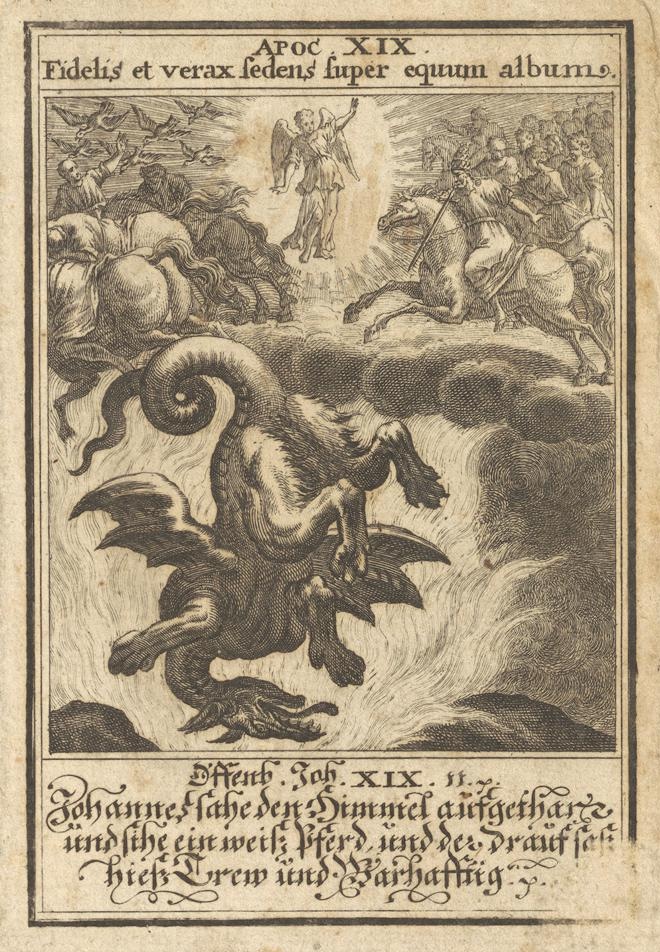The Biblia Ectypa
Analysis:
Relation Between Text and Image in Chapter 19

This engraving represents one of the main events described in Revelation, chapter 19. It is the culminating imagery of the beast being cast into a lake of fire and the return of Christ as the rider on the white horse, another of the main focuses in this chapter. The presented engraving includes several signs related to the Apocalypse vision. Several verses of this chapter come together in this illustration, for which what follows is a detailed analysis of its elements.
Starting with the angel, it is clear that he is centrally positioned above the chaos that unravels below, while maintaining an authoritative posture. His outstretched arms and radiance express its act of proclaiming the Apocalyptic message. The angel standing in the sun is symbolic of enlightenment, clarity, and a message from the Divine. His central elevated placement represents the divine authority and the connection to the heavenly realms, while tying the divine host above and the fallen beast below through its mediating role. It represents the passage from the victory of Christ to judgment on the reprobates, portrayed by the beast. This imagery very much reflects verse 17 of Revelation, chapter 19, in the King James Version.
Furthermore, in the upper left corner of the illustration, it is possible to see birds flying toward a crowd of people and horses. It is here that the angel, by crying out to the birds of the sky to gather for the “supper of the great God”, becomes a herald of divine justice and retribution against the forces of evil. This scene is clearly depicted in chapter 19, verses 17-18. His call for the birds to gather for a “supper” can be considered as a symbolic image common in the circles of the Bible and theology. Usually, it is a sign of a divine judgment or an after-effect of a great battle where enemies of God were defeated1. In this case, the “supper” denotes a feast for the birds on the flesh of those who have opposed God’s authority, the crowd on the upper left corner. This is to show completeness of their defeat, and the accomplished divine justice.
As for the beast, as it is very commonly represented, it is a grotesque creature, serpentine or draconic in nature. The beast squirms around in defeat below the forces of the heavens. The strong contrast of the upper-heavenly and lower-earthly divisions emphasize the dichotomy between good and evil. The creature, best described as the beast in the verses 19 and 20 of chapter 19, represents the forces of evil. Its contorted pose speaks of its imminent defeat and subjugation under divine judgment. The contrast between the martial forces that protect and defend the heavens and their singular focus to vanquish the forces of evil once and for all becomes heightened due to the fact that the beastly figure is the lone occupier of the bottom portion of the image, as though representing an ultimate goal. One can distinguish the heavenly light versus the light of all-consuming hellfire.
The figure of the rider on the white horse fills the upper right part of the composition, full of majesty and power. The horse is rearing high in dynamic movement, and the rider is represented with outstretched arms, perhaps alluding to divine authority. Surrounding the rider are the armies of heaven, they too on horseback, remaining as one heavenly host in unison, showing their celestial strength. This imagery is explicitly described in verses 11 and 14. The white horse is probably a symbol of purity. As for the rider, it is supposed that he is Christ, shown as a stately and commanding figure. His position above all others, arms outstretched, with the armies of heaven accompanying him, speaks much to His authority, justice, and role as the “Word of God”.
Regarding the artistic style of the engraving, fine lines and hatching give the engraving depth, texture, and drama. The swirling clouds around the heavenly host, or the contorted form of the beast, create movement and intensity. The gleaming, raised figure of the angel contrasts vividly with the dark, confusing tumult of the beast below, symbolizing the triumph of light over darkness. This illustration captures an intervention of God, in a scene full of action, emotion and intensity. The upward gaze of the figures and horses for their implied movement is dynamic. Accompanying the image are some texts, the upper part in Latin and the lower, in German. The texts depicted with the illustration clearly make a reference to verse 11. These Latin and German inscriptions add to the viewer’s comprehension of the scene.
👉 Below, here are the transcription and translation of both texts:
The Latin sentence: "APOC. XIX. Fidelis et verax sedens super equum album"
Translation: "Revelation 19: Faithful and true, sitting on a white horse"
The German sentence: "Johannes sahe den Himmel aufgethan, und siehe ein weiß Pferd, und der drauf sitzet, heißt Treu und Wahrhaftig"
Translation: "John saw the heavens opened, and behold, a white horse, and the one who sits upon it is called Faithful and True"
The image is an encapsulation of the victory of Christ over evil as foretold in Revelation 19. This picture acts as both a devotional tool and a warning of God’s judgment.
- Another example of this can be found in 1 Samuel 17:46, which states “This day will the Lord deliver thee into mine hand; and I will smite thee, and take thine head from thee; and I will give the carcases of the host of the Philistines this day unto the fowls of the air, and to the wild beasts of the earth; that all the earth may know that there is a God in Israel”. In so doing, David vows to give the bodies of the Philistines to the birds of the heavens. ↩︎



